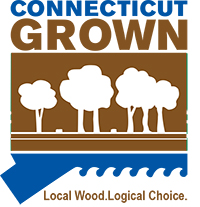CT Grown Forest Products

The Connecticut Grown Forest Products Program promotes products made from trees grown in Connecticut.
By purchasing these products, you make a statement in support of Connecticut’s forests, including those owned by private woodland owners. The economic values of locally sourced wood products are incentive for landowners and communities to manage their woodland and not convert the land to other uses.
Use the CT Grown Forest Products and Primary Producers Map to locate products and producers.

More About the Program:
The Connecticut Grown Program began in 1986, with the introduction of the now familiar green and blue logo to identify agricultural products grown in the state.
In January 2011, the Department of Energy and Environmental Protection (DEEP) and the Department of Agriculture (DOA) reached an historic agreement to include products from Connecticut's forests in this widely known program.
Connecticut is a state rich in forest resources. The wide variety of timber and non-timber forest products that come from its forests include:
- lumber
- timbers and beams
- flooring
- fencing
- landscape mulch
- maple syrup
Wood from Connecticut's trees is also used in the manufacturing of items as wide ranging as:
- fine furniture
- wooden bowls
- specialty items, such as the masts of tall ships and wooden boat timber
Requirements within the Connecticut Grown Forest Products Program assure that "Connecticut Grown" forests are managed in a sustainable and responsible manner.
The Connecticut Grown Forest Products Program is administered by the Division of Forestry in cooperation with the Connecticut Department of Agriculture.
How to Register as a Connecticut Grown Forest Products Producer:
Submit an application - Word Form / PDF. After initial review of the application, you will be required to provide evidence of compliance with the program requirements.
Forest products sold as Connecticut-Grown:
- Must be harvested, grown and produced using sustainable forestry practices. Conversion of forest land to non-conservation uses is unacceptable.
- Must be harvested, grown and produced utilizing best management practices as described in DEEP's current Field Guide for Best Management Practices for Water Quality While Harvesting Forest Products.
- Must be harvested, grown, and produced in compliance with the Connecticut Forest Practices Act (Section 23-65f through 23-65o of the Connecticut General Statutes).
- May include trees from urban forests provided there is evidence of a program of urban tree sustainability.
- Must be harvested, grown and produced in Connecticut in compliance with Section 22-38 of the Connecticut General Statutes. Records must be maintained to document that the product came from Connecticut and was produced in a sustainable manner. Products sold under the CT Grown label must have an origin traceable to Connecticut.
Note: Requirement - Forest products harvested to convert the acreage from forestland to a non-agricultural use such as parking lot(s), residence(s), commercial or industrial building(s) are unacceptable as the product was not the result of a "sustainable" forest practice. If the product was harvested from conversion of forestland to agricultural cropland or pastureland, the product would be acceptable because the land is "conserved" in its ability to grow plants, sustain animals, etc.
CT Grown Forest Products producers can also become State of Connecticut vendors, so that their products can be purchased and utilized by the state. For more information on the process of becoming a Connecticut State Vendor, visit the DAS Website to learn more and Register as a Vendor.
For further information on the Connecticut Grown Forest Products Program or other topics related to the production of forest products in Connecticut, please contact:
Nick Zito, DEEP Division of Forestry
860-424-3837
nicholas.zito@ct.gov
Content last updated December 2024.

